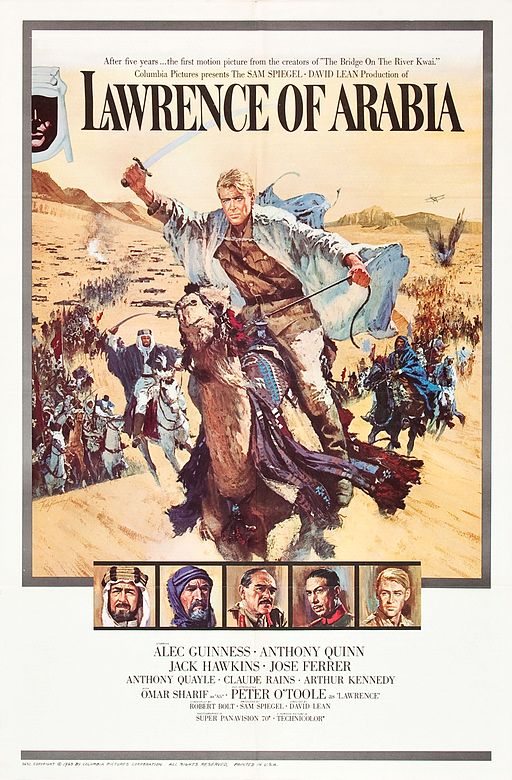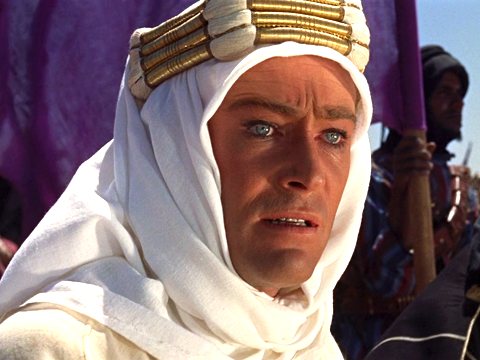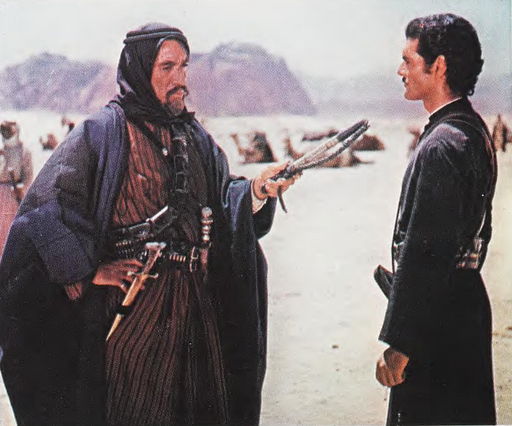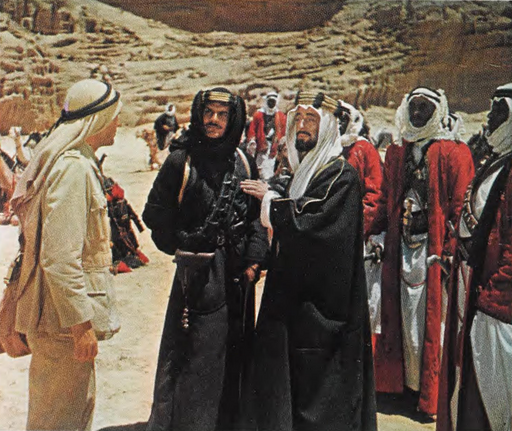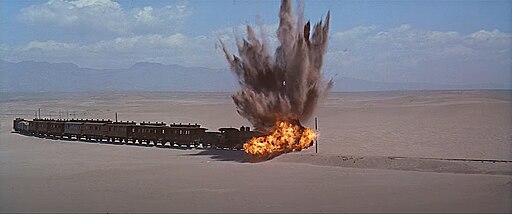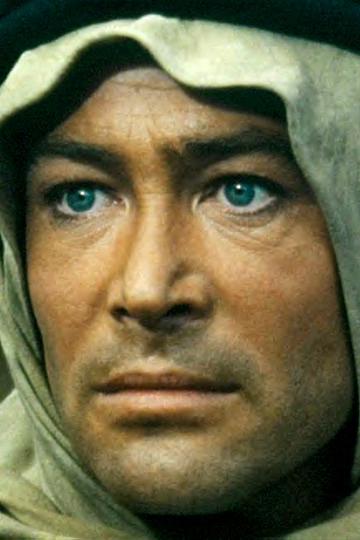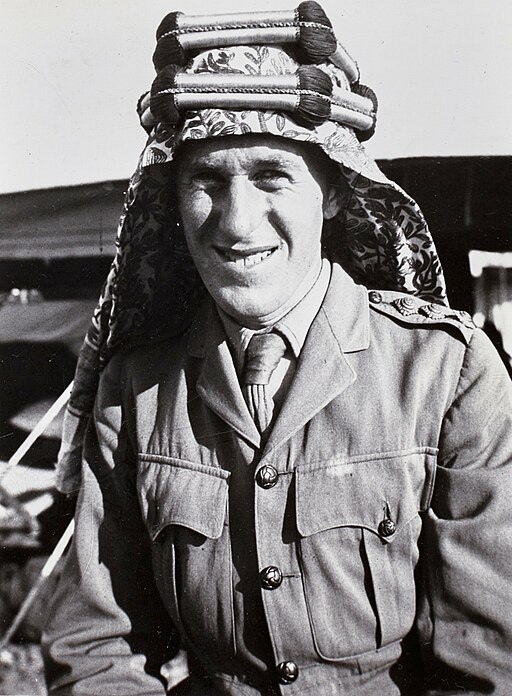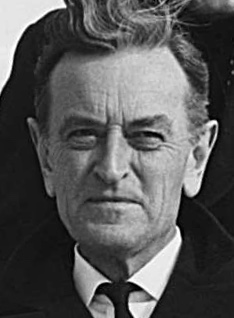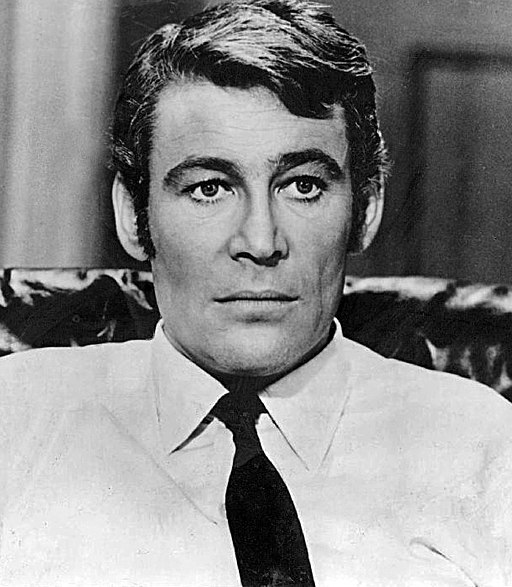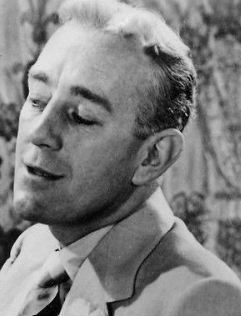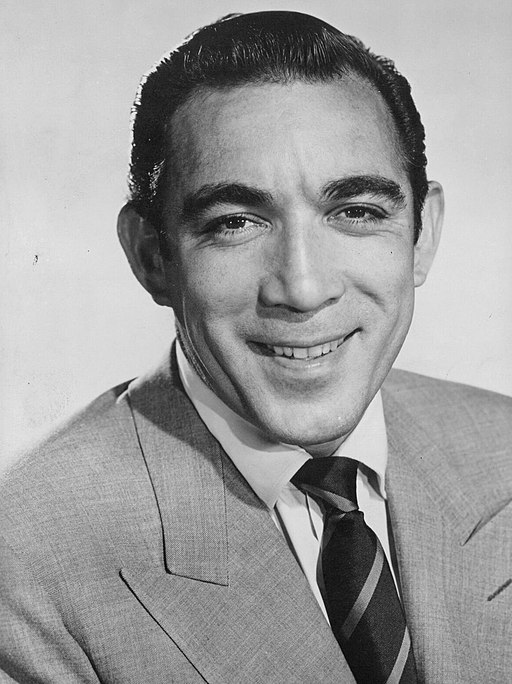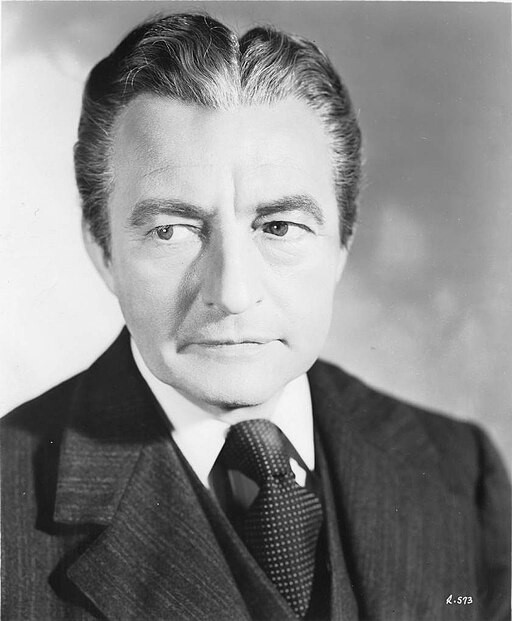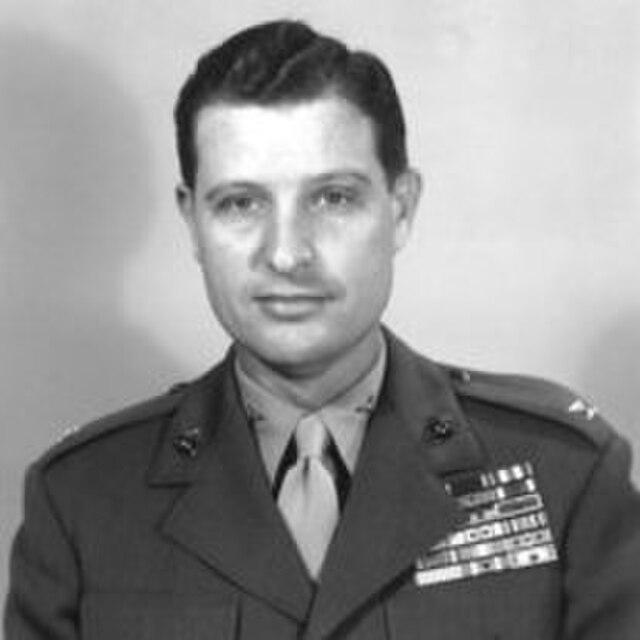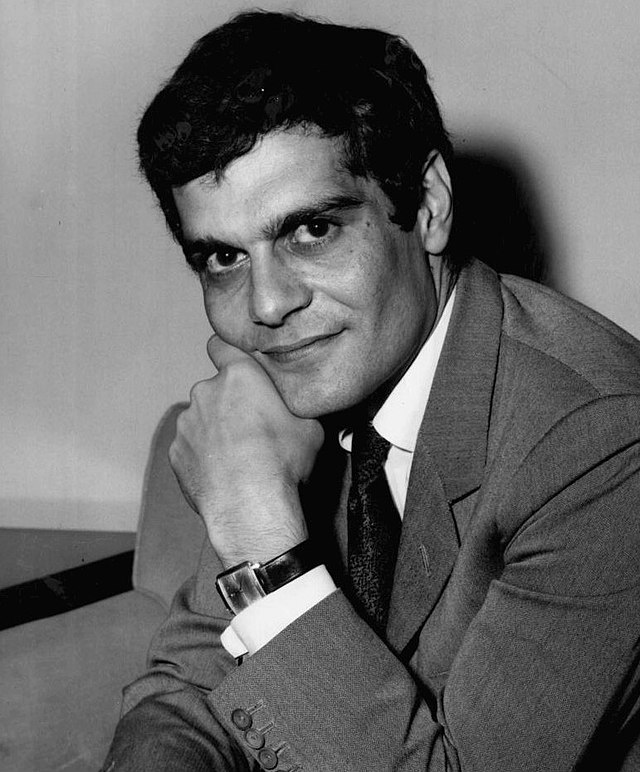Lawrence of Arabia - 1962
back| Released by | Columbia Pictures |
| Director | David Lean |
| Producer | Sam Spiegel |
| Script | Screenplay by Robert Bolt and Michael Wilson, based on the life of T.E. Lawrence and his writings |
| Cinematography | Freddie Young |
| Music by | Maurice Jarre |
| Running time | 228 minutes |
| Film budget | $15 million |
| Box office sales | $70 million (initial release) |
| Main cast | Peter O'Toole - Alec Guinness - Anthony Quinn - Jack Hawkins - Jose Ferrer |
Lawrence of Arabia
A visually stunning epic about legendary figure T.E. Lawrence and the desert he loved
"Lawrence of Arabia" is an epic historical drama that tells the story of British Army officer T.E. Lawrence and his experiences in the Arabian Peninsula during World War I. The film is celebrated for its grand scale, stunning desert cinematography, magnificent score, and Peter O'Toole's iconic performance in the titular role.
It is widely regarded as one of the greatest and most influential films in the history of cinema.
The film's portrayal of Lawrence's complex character and the political intrigue of the time, coupled with its breathtaking visuals and direction, have made it a cinematic landmark.
"Lawrence of Arabia" won numerous awards, including seven Academy Awards, and continues to be revered for its artistic achievements and its portrayal of a fascinating historical figure. David Lean's direction, along with the screenplay, music, and cinematography, has ensured the film's enduring status as a masterpiece in epic filmmaking. Bovenkant formulier
Related
Lawrence of Arabia
Analysis of the Movie, all Awards and Famous Quotes
"Lawrence of Arabia," directed by David Lean in 1962, is a cinematic epic renowned for its grandeur, intricate storytelling, and deep character exploration. Here is a full analysis of the movie:
Narrative and Themes:
- Epic Storytelling: The film chronicles the life of British Army officer T.E. Lawrence and his role in the Arab Revolt during World War I. It explores themes of identity, conflict, heroism, and the clash of cultures.
- Character Complexity: Central to the narrative is the enigmatic and complex character of Lawrence, portrayed masterfully by Peter O'Toole. The film delves into his psyche, examining his motivations, his struggles with identity, and his relationship with violence and power.
- Political and Cultural Context: The film also addresses the political dynamics of the era, including the British and French interests in the Middle East, and portrays the diverse cultures and tribes within the Arabian Peninsula.
Cinematography and Visuals:
- Sweeping Desert Landscapes: Freddie Young’s cinematography captures the vast, harsh beauty of the desert. The film is famous for its wide shots that emphasize the daunting scale of the landscape.
- Visual Storytelling: The use of color, light, and shadow plays a significant role in setting the tone and advancing the story. The visuals are not just stunning; they are integral to the narrative.
Direction:
- David Lean’s Vision: Lean's direction is both grand and meticulous. He crafts each scene with attention to detail, ensuring that every element, from the performances to the visuals, contributes to the overall impact of the film.
- Pacing and Structure: Despite its length, the film maintains a compelling narrative flow. Lean balances action sequences with introspective moments, keeping the audience engaged throughout.
Performances:
- Peter O’Toole’s Performance: O'Toole delivers a charismatic and layered performance. He portrays Lawrence as both a visionary leader and a conflicted man, torn between different worlds and loyalties.
- Supporting Cast: The ensemble cast, including Alec Guinness, Anthony Quinn, and Omar Sharif, provides strong performances that add depth to the film. Their portrayals of various historical figures are nuanced and compelling.
Music and Sound:
- Maurice Jarre’s Score: The film’s score is iconic and significantly enhances its emotional and dramatic impact. The music complements the visuals and narrative, adding to the epic quality of the film.
Themes and Symbolism:
-
Conflict and Duality: Lawrence's internal conflict and his struggle with his identity are central themes. The film explores the duality of his character – as a British officer and a leader in the Arab world.
- The Allure and Brutality of War: The film portrays the allure of adventure and heroism in war, but it also does not shy away from showing the brutality and the human cost of conflict.
Cultural Impact and Legacy:
- Influence on Filmmaking: "Lawrence of Arabia" set new standards for epic cinema. Its influence can be seen in numerous subsequent films, both in its storytelling and visual approach.
- Historical and Cultural Reflection: The film offers a reflection on historical events, though it takes some creative liberties. It remains a subject of study for its portrayal of historical figures and events.
In summary, "Lawrence of Arabia" is a masterpiece of epic filmmaking, combining stunning visuals, powerful performances, and a compelling narrative. David Lean’s direction, along with the film’s technical and artistic achievements, makes it a landmark in cinematic history, celebrated for its portrayal of a complex individual and a critical period in the 20th century.
Full Cast of “Lawrence of Arabia”:
- Peter O'Toole as T.E. Lawrence
- Alec Guinness as Prince Feisal
- Anthony Quinn as Auda Abu Tayi
- Jack Hawkins as General Allenby
- Omar Sharif as Sherif Ali
- José Ferrer as Turkish Bey
- Anthony Quayle as Colonel Brighton
- Claude Rains as Mr. Dryden
- Arthur Kennedy as Jackson Bentley
- Donald Wolfit as General Murray
- I.S. Johar as Gasim
- Gamil Ratib as Majid
- Michel Ray as Farraj
- John Dimech as Daud
- Zia Mohyeddin as Tafas
- Howard Marion-Crawford as Medical Officer
- Jack Gwillim as Club Secretary
- Hugh Miller as RAMC Colonel
- Kenneth Fortescue as Farraj's Companion
- Harry Fowler as William Potter
Filming Locations “Lawrence of Arabia”:
The filming of "Lawrence of Arabia" (1962), directed by David Lean, is famous for its stunning use of real-world locations, primarily in the Middle East and Europe. These locations were crucial in bringing the epic scale and authenticity to the film. Here's an overview of some key filming locations:
Jordan:
- Wadi Rum: Many desert scenes were shot in Wadi Rum, known for its dramatic sandstone and granite rock formations. Its landscape provided the perfect backdrop for the Arabian desert setting of the film.
- Aqaba: The actual city of Aqaba, which plays a significant role in Lawrence's military campaigns, was also a filming location.
Morocco:
- Morocco was used for several scenes, including some depicting the city of Damascus. The diverse landscapes of Morocco helped in portraying different parts of the Arabian Peninsula.
Spain:
- Seville and Almería: Parts of Spain, including Seville and the province of Almería, were used to replicate the Middle Eastern architecture and landscapes. Spanish locations doubled for cities like Cairo and Jerusalem.
- The Tabernas Desert: Located in Almería, this desert was used for many of the film's expansive desert scenes.
United Kingdom:
- Some interior scenes, including those set in the British Army headquarters and offices, were filmed in the UK, utilizing the Shepperton Studios in Surrey.
The choice of these locations added a level of authenticity and grandeur that would have been difficult to achieve with studio backdrops or set constructions alone. David Lean's insistence on shooting in actual desert conditions added to the film's visual authenticity, although it presented significant logistical challenges.
Analysis of the Direction of David Lean:
David Lean's direction of "Lawrence of Arabia" (1962) is a testament to his mastery of epic cinema and his ability to weave complex narratives with visual grandeur. Here’s an analysis of his directorial approach:
Epic Scope and Visual Storytelling:
- Grandeur and Scale: Lean’s vision for "Lawrence of Arabia" was grand in scale, capturing the vastness and beauty of the desert. He utilized wide shots extensively, making the desert a character in itself – imposing, magnificent, and relentless.
- Attention to Detail: Despite the film's vast scale, Lean’s attention to detail is meticulous. Every scene is carefully crafted, from the sweeping battle sequences to the intimate character moments.
Cinematography and Composition:
- Collaboration with Freddie Young: Working with cinematographer Freddie Young, Lean created some of the most memorable images in cinematic history. The use of 70mm Super Panavision enhanced the film's visual impact, offering breathtaking panoramas and detailed close-ups.
- Symbolic Use of Landscape: The desert landscapes are used symbolically to reflect Lawrence's internal journey – from the freedom and expanse of open dunes to the treacherous and confining rocky passes.
Narrative and Pacing:
- Complex Storytelling: Lean manages the complex narrative with skill, maintaining clarity while weaving together the multiple facets of Lawrence’s life and the political intrigues of the era.
- Pacing: Despite its length, the film is paced in a way that maintains engagement. Lean balances action with character development, ensuring that the emotional depth of the story is not lost amidst the epic backdrop.
Character Development:
- Focus on Lawrence’s Psyche: Lean delves deeply into T.E. Lawrence’s psyche, exploring his complexities, contradictions, and the burdens of his unique position. Peter O'Toole’s nuanced performance, under Lean’s direction, brings this enigmatic figure to life.
- Supporting Characters: Lean gives due attention to the supporting characters, each contributing to the narrative and the film’s exploration of broader themes like colonialism and cultural conflict.
Use of Music and Sound:
- Collaboration with Maurice Jarre: The film’s score, composed by Maurice Jarre, is integral to its emotional impact. Lean’s use of music underscores the narrative, enhancing the sense of drama and grandeur.
Legacy and Influence:
- Benchmark for Epic Cinema: "Lawrence of Arabia" set a new benchmark for the epic film genre. Its influence is evident in the way subsequent epics are made, particularly in terms of visual style and narrative scope.
- Influence on Filmmakers: Lean’s direction inspired generations of filmmakers. His ability to combine a compelling story with visual splendor remains a gold standard in cinema.
Analysis of the Performance of Peter O’Toole as Lawrence:
Peter O'Toole's portrayal of T.E. Lawrence in "Lawrence of Arabia" is a defining performance in cinema history, marked by its complexity, depth, and emotional range. Here's an analysis of his role:
Character Complexity:
- Multifaceted Portrayal: O'Toole presents Lawrence as a deeply complex character, capturing his charisma, intelligence, and the internal conflicts that drive him. He skillfully navigates the nuances of Lawrence’s personality – from his enigmatic and almost mystical presence to his moments of vulnerability and torment.
- Transformation Over the Film: O'Toole charts Lawrence’s transformation throughout the film, from an eccentric and ambitious lieutenant to a battle-hardened, yet disillusioned, figure. His portrayal of this journey is both compelling and deeply human.
Emotional Range:
- Intensity and Subtlety: O'Toole's performance is characterized by both its intensity and subtlety. He conveys a wide range of emotions – from the exhilaration of victory to the agony of self-doubt and despair. His ability to express profound emotions through subtle facial expressions and body language adds a layer of depth to the character.
Physicality and Presence:
- Commanding Screen Presence: O'Toole’s physicality adds to the larger-than-life aspect of the character. His tall frame, piercing blue eyes, and charismatic presence make his Lawrence a compelling figure on screen.
- Expression of Inner Turmoil: Through his physical performance, O'Toole communicates Lawrence’s inner turmoil, especially in scenes depicting the harsh realities of desert warfare and Lawrence’s internal conflict about his role in the Arab Revolt.
Interaction with Other Characters:
- Dynamic Relationships: O'Toole’s interactions with other characters, including Sherif Ali (Omar Sharif) and Prince Feisal (Alec Guinness), are dynamic and reflect the complexities of Lawrence’s relationships with both his British superiors and Arab allies.
Impact of the Role:
- Career-Defining Performance: O'Toole’s portrayal of Lawrence is a career-defining role. It showcased his extraordinary talent and established him as one of the finest actors of his generation.
- Contribution to Film’s Success: His performance is central to the film’s success, providing an anchor for its sprawling narrative and epic scope.
In summary, Peter O'Toole’s portrayal of T.E. Lawrence is a masterful interpretation of one of history’s most enigmatic figures. His performance brings a blend of intensity, charisma, and depth to the character, making it not only a high point in his career but also a standout in the annals of cinematic history.
Analysis of Alec Guinness’s Performance as Prince Feisal:
Alec Guinness's portrayal of Prince Feisal in "Lawrence of Arabia" (1962) is a pivotal performance that adds depth and gravitas to the epic narrative. His interpretation of Feisal is marked by subtlety and a nuanced understanding of the character's historical and cultural significance. Here's an analysis of his role:
Portrayal of Leadership and Wisdom:
- Regal Demeanor: Guinness portrays Feisal as a leader who is both regal and measured. His performance exudes a sense of calm authority and intelligence, befitting a prince leading his people in a time of upheaval.
- Strategic Wisdom: Feisal is depicted as a strategic thinker, acutely aware of the political intricacies of the Arab Revolt and the involvement of Western powers. Guinness conveys this through his thoughtful dialogue delivery and contemplative expressions.
Cultural Sensitivity and Depth:
- Representation of Arab Leadership: At a time when Western portrayals of Arab characters were often one-dimensional, Guinness’s portrayal of Feisal stands out for its depth and dignity. He brings a level of respect and complexity to the character, avoiding caricature.
- Understanding of Historical Context: Guinness's performance reflects an understanding of the historical context of Feisal's struggle for Arab independence. His portrayal suggests an awareness of the broader implications of the conflict and its future impact.
Interaction with Other Characters:
- Dynamic with Lawrence: The interactions between Feisal and T.E. Lawrence (Peter O'Toole) are significant, highlighting the mutual respect and yet the underlying tension between the two. Guinness effectively portrays Feisal’s cautious embrace of Lawrence’s assistance while maintaining a careful watch over his own and his people's interests.
- Diplomatic Acumen: In scenes with British officers, Guinness displays Feisal's diplomatic skills. He portrays the prince as a man navigating the complex dynamics between his own aspirations for his people and the machinations of colonial powers.
Contribution to the Film’s Themes:
- Representation of Arab Nationalism: Through his portrayal of Feisal, Guinness contributes to the film's exploration of Arab nationalism and the struggle for self-determination. He presents Feisal as a symbol of these broader themes.
- Moral Complexity: Guinness adds to the film's moral complexity, depicting Feisal as a character caught between traditional loyalties, the desire for independence, and the realities of geopolitical strategy.
Legacy:
- Memorable Performance: While “Lawrence of Arabia” is primarily focused on Lawrence’s character, Guinness’s portrayal of Feisal remains memorable for its sophistication and depth, adding a crucial layer to the film’s portrayal of historical events.
In conclusion, Alec Guinness's performance as Prince Feisal is a testament to his skill as an actor capable of bringing historical figures to life with dignity and complexity. His contribution to "Lawrence of Arabia" is significant, providing insight into the Arab perspective of the events depicted and enhancing the film’s overall depth and historical authenticity.
Remarkable Quotes from “Lawrence of Arabia”:
T.E. Lawrence (Peter O'Toole): "All men dream: but not equally. Those who dream by night in the dusty recesses of their minds wake in the day to find that it was vanity: but the dreamers of the day are dangerous men, for they may act their dreams with open eyes, to make it possible."
Prince Feisal (Alec Guinness): "Young men make wars, and the virtues of war are the virtues of young men. Courage and hope for the future. Then old men make the peace, and the vices of peace are the vices of old men. Mistrust and caution."
Lawrence: "Nothing is written."
- A recurring line in the film that reflects Lawrence’s belief in free will and shaping one's own destiny, contrary to fatalistic views.
Sherif Ali (Omar Sharif): "He is not perfect." Feisal: "No Arab loves the desert. We love water and green trees. There is nothing in the desert. No man needs nothing."
- This exchange captures the essence of the Arab perspective on their land and challenges Lawrence's romanticized view of the desert.
Lawrence: "The trick, William Potter, is not minding that it hurts."
- Said while extinguishing a match with his fingers, demonstrating Lawrence's unique ability to endure pain, a metaphor for his broader experiences in the desert.
Mr. Dryden (Claude Rains): "A man who tells lies, like me, merely hides the truth. But a man who tells half-lies has forgotten where he put it."
- A line that speaks to the complex nature of truth in the context of war and politics.
Lawrence: "Do you think I'm just anybody, Ali? Do you?"
- Reflecting Lawrence's internal struggle with his identity and his role in the Arab Revolt.
Jackson Bentley (Arthur Kennedy): "What attracts you personally to the desert?" Lawrence: "It's clean."
- A simple yet profound statement that reflects Lawrence’s love for the purity and simplicity of the desert, in contrast to the complexities of civilization.
General Allenby (Jack Hawkins): "I thought I was a hard man, sir." Feisal: "You are merely a general. I must be a king."
- This line underscores the heavy responsibilities and the different roles each character plays in the context of war and leadership.
Awards and Nominations:
Academy Awards (1963):
- Best Picture: Won
- Best Director (David Lean): Won
- Best Art Direction-Set Decoration, Color: Won
- Best Cinematography, Color (Freddie Young): Won
- Best Sound (John Cox): Won
- Best Film Editing (Anne V. Coates): Won
- Best Music, Score - Substantially Original (Maurice Jarre): Won
- Best Actor in a Leading Role (Peter O'Toole): Nominated
- Best Actor in a Supporting Role (Omar Sharif): Nominated
- Best Writing, Screenplay Based on Material from Another Medium (Robert Bolt, Michael Wilson): Nominated
Golden Globe Awards:
- Best Motion Picture - Drama: Won
- Best Director - Motion Picture (David Lean): Won
- Best Actor in a Motion Picture - Drama (Peter O'Toole): Won
- Best Supporting Actor - Motion Picture (Omar Sharif): Won
- Best Cinematography - Color: Won
BAFTA Awards:
- Best Film from any Source: Won
- Best British Actor (Peter O'Toole): Nominated
- Best British Screenplay: Nominated
Directors Guild of America (DGA):
- Outstanding Directorial Achievement in Motion Pictures (David Lean): Won
New York Film Critics Circle Awards:
- Best Film: Won
- Best Director (David Lean): Won

